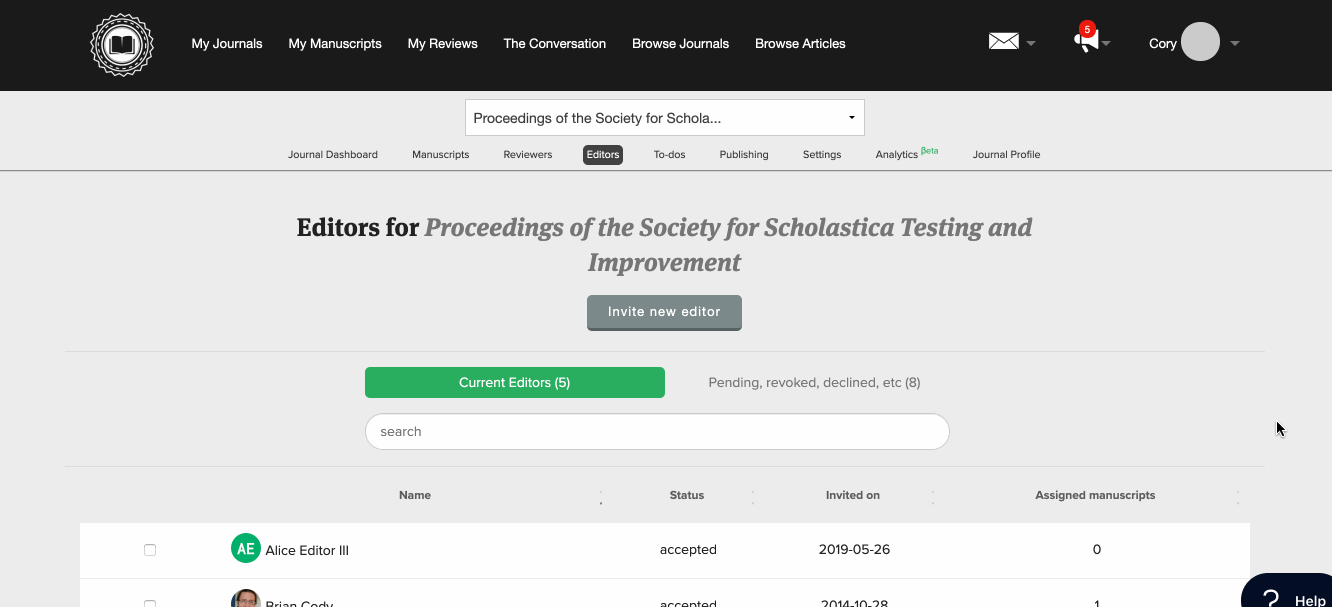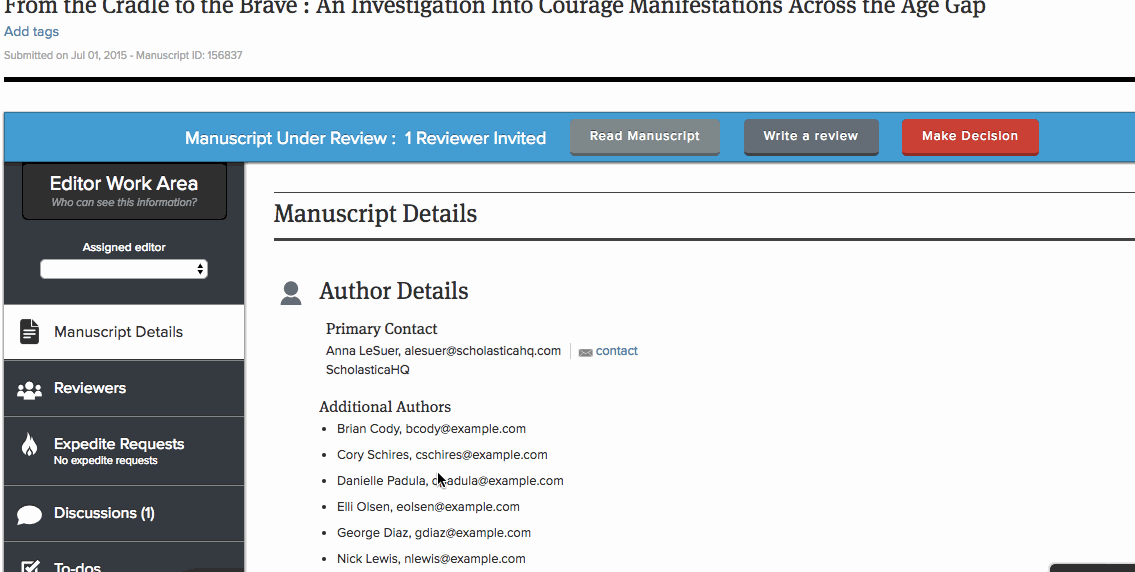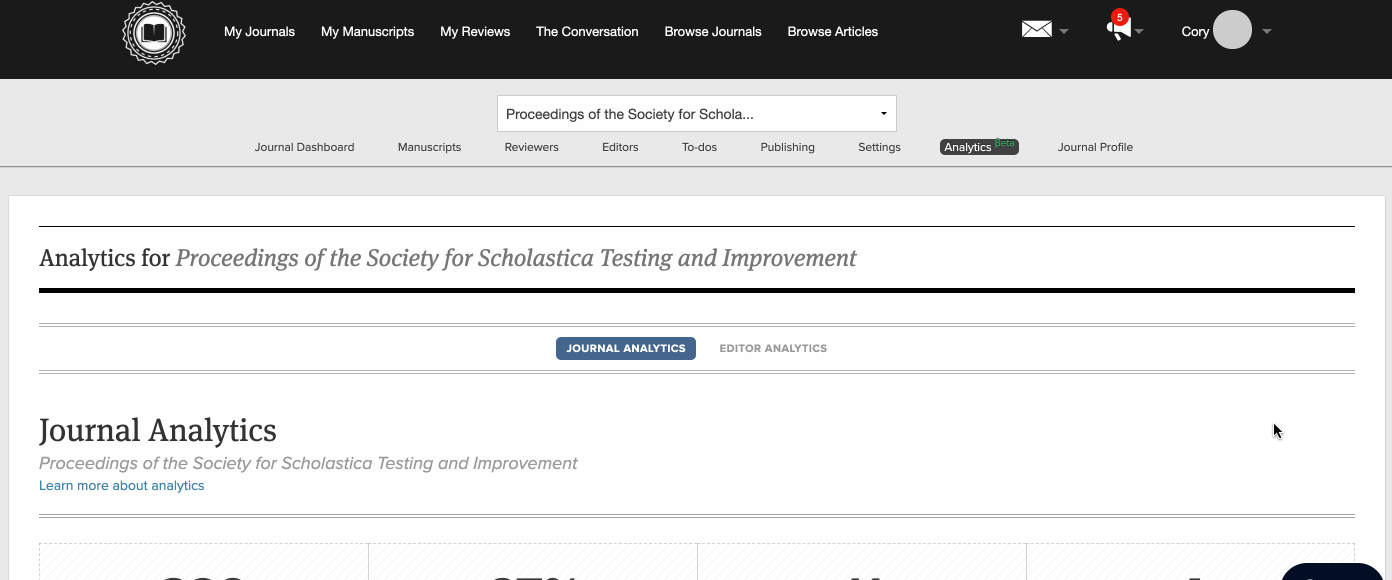
The prospect of migrating to new peer review software is exciting, presenting the opportunity to increase efficiencies and improve your journal’s submission and manuscript management process for editors, authors, and reviewers. But, it can also feel a little overwhelming with many moving parts and pieces to consider. If you’re thinking about moving to Scholastica’s peer review system, we know your team likely has a lot of questions like:
- How long will the transition to Scholastica take?
- What if we need help — will we receive training and customer support?
- What types of workflow configurations does Scholastica offer?
- Does Scholastica include peer review analytics?
- What has moving to Scholastica’s peer review system been like for other journals?
You may also still be exploring Scholastica’s software and looking to learn more about the benefits. Well, you’ve come to the right place! This post covers everything you need to know about migrating one or more journals to Scholastica’s peer review system and key features to streamline your editorial workflows, making life easier for editors, authors, and reviewers.
Before we dive in, you should know that there are three sides to Scholastica — our peer review system, production service, and open access journal hosting platform. Our software and services can be used separately or seamlessly integrated to help you bridge gaps between editorial workflows, production, and publishing. If you’re interested in learning more about our other software and services, you can get a behind-the-scenes look at Scholastica’s production service here and our OA publishing platform here. Scholastica has no contracts, so you can start and stop using our solutions any time, and we offer standardized format content and data exports whenever needed (e.g., XML, JSON, etc.).
Should you decide to use any of Scholastica’s software and services, we promise that your transition will be fast and easy! We offer intuitive ready-to-go solutions and provide free training for all users, as well as free unlimited customer support.
Further reading: If you’re unsure whether now’s the right time for your team to move to a new peer review system, check out our blog “7 Tips if you’re thinking about changing journal peer review software.” In it, we cover how to assess your current workflow needs and successfully transition to new software if you decide to make a switch.
Now, without further ado, here’s what to expect when transitioning to Scholastica’s peer review system.
Quick links
- Peer review account set up is fast and easy
- Get free user training and support
- Request custom submission form fields and instructions as needed
- Easily configure your journal account, invite editors, and import reviewers
- Manage all submissions and communication in one place across one or more journals
- Use analytics to track team performance and look for optimization opportunities
- Get instant access to new features and improvements
- See what others have to say about transitioning to Scholastica
Peer review account set up is fast and easy

How long does it take to start using Scholastica? You can migrate journals to our peer review system in as little as a few days following the simple steps outlined below. If you’re new to Scholastica, we recommend first requesting a free demo to walk through the platform with someone from our team. We’ll answer any questions you may have, get to know more about your journal to ensure Scholastica is the right fit, and help you determine the best next steps.
To begin using Scholastica’s peer review system, you’ll first need to create a user account. Once signed in, you’ll see the option to “start a journal“ on your user dashboard, which will initiate the process for setting up a journal in Scholastica and connecting it to our peer review system. At this point, you’ll enter basic journal information like the title, discipline, description, and editorial board. After you’ve followed the setup steps and are ready to make your journal public, click the button that says “all done and ready to be approved,” and a Scholastica representative will reach out shortly to verify your journal. Our team checks the editorial affiliations of all journals, and we adhere to the following policies to prevent predatory publications from using our software, so you can be sure only reputable journals are on Scholastica. Once that quick check is complete, we’ll make your peer review account live, and you’ll be able to start directing authors to it for submissions.
If you’re transitioning multiple journals to Scholastica, you’ll follow the same journal account setup process for each one. We recommend having the person who’ll manage each journal day-to-day (e.g., managing editor, editor in chief) follow the “start journal” process described above from their individual user account. That way, they can take on the role of admin editor right away. They’ll be able to start getting acquainted with the system and invite editors to the journal.
Don’t worry — you won’t be on your own during the setup process! A Scholastica customer support specialist will reach out to schedule a personal training for each journal you transition to the platform.
Get free user training and support
We’ve designed Scholastica’s software to be as intuitive as possible so editors can jump into our peer system and start using it right away. We also recommend scheduling a free training to help your editors and publishing staff get onboarded and learn all the workflow optimization features Scholastica has to offer. As noted above, a Scholastica customer support specialist will reach out to set up your free training. If everyone can’t make the same time, no problem! We record training sessions and provide additional support as needed.
Before the training, our support specialist will ask your team to share a brief overview of your journal’s current processes. They’ll use that information to determine how to make your workflow as efficient as possible in Scholastica and walk you through it. Scholastica also offers free user support to authors and reviewers, so your team won’t have to worry about fielding any technical questions as they’re getting accustomed to the system.
Some quick tips we recommend to all journals when transitioning to Scholastica’s peer review system:
- Focus on the outcomes you want for your journal rather than sticking strictly to how your workflow used to operate (this will help you make optimizations)
- Make a clean switch to Scholastica — finish up any in-progress manuscripts on your current system and, as soon as possible, start directing authors to submit via your new Scholastica account
- Send all new messages to editors, authors, and reviewers using Scholastica Discussions, so your communication in Scholastica and your old system stay separate, and nothing falls through the cracks
Request custom submission form fields and instructions as needed

At Scholastica, we know every journal has specific manuscript criteria, and we want to help editors receive correct and complete submissions the first time around (not after a series of follow-up emails). That’s why we’ve introduced customization options to help journals using our peer review system add special instructions for authors to their submission forms and gather/require additional manuscript details when needed.
Journals using Scholastica’s Peer Review System can request any combination of the following submission form customization options by following the steps in this help doc:
- Article type menu: Make it easier for editors to manage different types of submissions by adding an “article type” dropdown to your submission form. Article type data is carried over to the Manuscripts Table so you can search for/sort submissions by type, and it’s included in editor and reviewer manuscript work areas. As a best practice, we recommend journals use article types that correspond to the industry-standard options included in JATS, though article types can be unique to your journal’s needs.
- Affirmations section: Check that authors are aware of and complying with your journal’s guidelines (e.g., ethical policies) by adding an “affirmations” section to your submission form. Authors will be required to check affirmations prior to submitting.
- Author detail requirements: Make specific submission fields required so you always get the author details you need. You can require any of the following fields: ORCID iDs, institution (we’ll automatically associate matching ROR IDs as applicable), department, degrees, corresponding author emails, personal website.
- CRediT fields: If your journal wants to require or give authors the option to input details for all manuscript contributors, you can request to have Contributor Roles Taxonomy (CRediT) fields, the NISO standard, added to your submission form. Scholastica will then automatically generate bibliographic JATS XML metadata for all articles, including CRediT inputs, which is available for export from Manuscript Details pages as needed.
- Custom file upload fields: If your journal needs or encourages authors to submit certain accompanying files with their manuscripts (e.g., conflict of interest statement), you can add required and optional upload fields for those items to your submission form.
- Funding sources section: If your journal wants authors to, or if your authors need to, provide details about article funding, you can add a “Funding Sources” section to your journal submission form. Authors can enter the following fields: funder name, grant number, and grant recipient. The funder name field pulls from the Crossref Funder Registry, so authors can easily find the correct funder/grant issuer details.
- Special instructions for authors: Are there instructions you want authors to see at different points in your submission process? You can add custom text to specific fields or sections (e.g., the metadata entry step) of your submission form with those details.
Scholastica’s submission form customization options come ready to go with no need for editors to wade through complex configurations. And they’re all available to journals using our peer review system at no added cost. Journals subscribed to multiple Scholastica products can also import metadata (e.g., ORCID iDs, CRediT inputs) from one solution to another to save time.
We cover everything you need to know about current submission form customization opportunities in this blog post.
Easily configure your journal account, invite editors, and import reviewers

As noted above, during your free training, a Scholastica customer support specialist will help you set up your journal account to have the most streamlined workflow possible. You can configure Scholastica in multiple ways, including:
- Choosing an anonymization setting (e.g., single-anonymized, double-anonymized)
- Setting preferences for automated emails to editors, authors, and reviewers (e.g., manuscript submission notifications, review reminders, and more)
- Customizing your reviewer feedback form to add/remove or re-order questions
- Setting up custom email templates — Scholastica offers fully customizable decision letter templates as well as Discussion email templates (more on Discussions below!)
- Creating manuscript tags to search and sort submissions with ease
Adding editors and reviewers to Scholastica is also fast and easy. During setup, your admin editor can invite all editors to your journal’s Scholastica account by clicking “Invite New Editor” from the Editors’ Table. Just enter the email addresses of all editors and input a quick message letting them know to accept the invitation and sign up for a personal Scholastica account to access your journal. You’ll be able to set permissions for each editor to ensure they have access to the papers they should.
To add reviewers to Scholastica, you’ll have the option to either send individual invitations or do a bulk import of your existing reviewer database. You’ll also be able to add tags to reviewers to help you sort them by the criteria of your choice, such as research specialties and past availability.
If you have manuscripts in another peer review system, you can also upload them to Scholastica on behalf of authors as “proxy submissions.” Though, for your convenience and to prevent author and reviewer confusion, we recommend that you finish reviewing any in-progress manuscripts in your legacy system. That will enable you to make a clean transition to Scholastica. Our team can help you determine the best plan for manuscript transitions. We also cover tips on how to make a clean switch to new software in this blog post.
Manage all submissions and communication in one place across one or more journals

With Scholastica, you can centralize all your peer review workflows and communication. When you log into Scholastica and navigate to your journal, the first thing you’ll see is your journal dashboard with a running log of your team’s latest activity, which you can quickly search to find when editors completed various actions. You’ll also see journal to-dos — Scholastica includes a to-do dashboard feature where you can assign tasks to yourself or other team members (e.g., reminders to do manuscript technical checks). You can easily filter to-dos by assignor or assignee and status.
From your Manuscripts Table in Scholastica, you’ll be able to track submissions with ease. You can search for specific papers and sort them by author, date submitted, review stage, and more using our powerful filters, and assign manuscripts to editors individually or in groups via bulk actions. You’ll then be able to invite reviewers to submissions from their manuscript work area page and manage all manuscript-related communication using Scholastica’s built-in email feature Discussions. Each manuscript work area page on Scholastica has a Discussions section where teams can start message threads with editors, authors, and reviewers. Recipients can view and respond to Discussions from Scholastica or their email, and all Discussion threads are saved in Scholastica with their corresponding manuscript.
Using Scholastica, peer review managers and managing editors working with more than one journal can also seamlessly track manuscripts and editorial workflows across multiple titles. From the user dashboard view, it’s easy to toggle between different journals to check their activity logs and to-dos and manage submissions.
Journals can also speed up their time to publication further when they integrate with Scholastica’s digital-first production service. You can import accepted manuscripts and metadata from our peer review system straight to our production service without any preformatting steps, saving editors and authors time. Our production team then uses a software-based process to generate PDF, HTML, and full-text XML article files from a single source, so they’re always properly formatted and in sync. Updates made to PDF or HTML versions during proofing are automatically applied to all other file types. Journals using our OA publishing platform can also publish typeset articles as soon as they’re ready in a few clicks.
Use analytics to track team performance and look for optimization opportunities

If you’re wondering what steps you can take to streamline your editorial workflows further, we also have tools to help. Scholastica’s peer review system features a built-in analytics suite that makes tracking peer review metrics easy so you can make more data-driven workflow decisions. Each journal account features an analytics page with real-time journal performance data and individual editor stats, including:
- Number of manuscript submissions by date
- Manuscripts in progress (with a breakdown by each phase of review)
- Number of manuscripts per editor (average and totals)
- Days to a decision at the journal and editor level (with breakouts by days to accept and days to reject)
- Acceptance and rejection rate at the journal and editor level
You can learn more about Scholastica’s peer review analytics in this help doc. Scholastica also includes built-in reviewer analytics. From the Reviewers Table, you can easily track reviewer performance stats, including:
- Pending invitations
- Pending and late review assignments
- Number of invitations received and date of last invite
- Number of reviews completed
- Average days to complete a review
With Scholastica’s built-in analytics, you can keep track of journal performance to ensure you’re receiving enough submissions and that editors and reviewers are completing manuscript tasks in a timely manner. Dig into the data to determine if and where you may have potential workflow bottlenecks and start taking steps to address them.
Should you need to look into a particular time period of journal activity or answer a question not covered in Scholastica’s analytics suite, you can also request a pull of your journal’s raw data at any time. Just contact us at support@scholasticahq.com.
Get instant access to new features and improvements
Using Scholastica, you can be sure that you’ll always have access to the latest software. We universally apply new features and system upgrades to all journal accounts as they become available, so you don’t have to wait for or install updates.
We’re always working to make Scholastica’s user experience better for editors, authors, and reviewers and stay at the forefront of the latest industry best practices. As a member of the Association of Learned and Professional Society Publishers (ALPSP), Open Access Scholarly Publishing Association (OASPA), and other leading industry bodies, we’re supporting the development and implementation of standards to improve research dissemination, discovery, and interoperability, starting with peer review. Follow our blog for all the latest feature updates.
See what others have to say about transitioning to Scholastica
We hope this overview of transitioning one or more journals to Scholastica’s peer review system was useful! Wondering what the transition experience has been like for other journals? You can check out our Customer Stories and Testimonials page to see what journal managers and editors have to say about moving to Scholastica.
To learn more about Scholastica’s peer review system, visit our website or schedule a free personal demo with a member of our team here.








